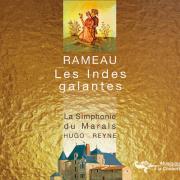Texte paru dans: / Appeared in:
*

GRAMOPHONE (11/2014)
Pour s'abonner /
Subscription information
Musique à la Chabotterie 605013

Code-barres / Barcode : 3770003333029
Reviewer:
David
Vickers
Rameau’s opéraballet Les Indes galantes (mostly 1735) examines why true love seems to have been abandoned in Europe and can now only be found in exotic faraway places, where the supposedly barbaric Turkish, Peruvian, Persian and Native American characters turn out to be more civilised than most of their European counterparts (there are a few notable contrary exceptions, such as the enlightened Spanish hero Carlos, who exposes the Inca priest Huascar’s dastardly scheme to ensnare Phani). A new edition of the score by Hugo Reyne and Nicolas Sceaux is now freely available online, and it reinstates numerous passages that Rameau later cut, such as the full original earthquake music in ‘The Incas of Peru’, which the composer was forced to abridge because the performers objected; they also restore his original orchestrations, thus remedying the unreliable reorchestrated Durand edition that misled trusting musicians for several generations.
Six core soloists perform all 17 roles in Reyne’s live recording made at Vienna’s Konzerthaus in January 2013. Valérie Gabail sings Zima’s triumphant song in praise of love and youth (‘Regnez Plaisirs et Jeux’, with trumpet, woodwind and timpani) with a full-bodied radiance and intelligence far beyond the coquettish mannerisms one sometimes encounters in other versions (although the Herculean approach to a concluding high D is a rare misstep). The highlight of the entrée ‘The Flowers of Persia’ is the sweetly balanced quartet ‘Tendre amour’ (albeit with the high tenor François-Nicolas Geslot slipping slightly under with some sustained repeated highest notes). The orchestra of La Simphonie du Marais play dances with charming élan but without the noise of actual steps (although one does hear page turns, creaking instruments and coughs from time to time). The thumping bass drum in the Pipe of Peace ceremony dance ‘Les Sauvages’ ensures that Rameau’s evocation of the Louisiana Sioux has never seemed so clearly realised, and the concluding chaconne features excellent playing from the trumpets and woodwind. The comprehensive booklet includes the full libretto (albeit in French only), and Reyne’s engaging essay includes detailed comments on Rameau’s music, illustrations both iconographical and musical, and a detailed synopsis. From every point of view that matters, this is a special Ramellian achievement.
Cliquez l'un ou l'autre
bouton pour découvrir bien d'autres critiques de CD
Click either button for many other reviews


